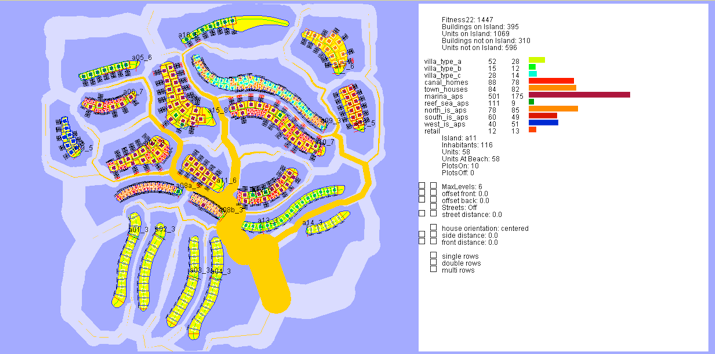PROJECTS
OQYANA, World First, Dubai (VAE)
2006
For several years, the interdisciplinary CAAD KAISERSROT research team is working on computer-aided methods to incorporate change, uncertainty, and choice into urban design contexts.
As in this case, the problem of uncertainty increases when the site involves piles of sand laying in the 33 degree warm waters of the Persian Gulf: The project’s layout on the islands hitherto has not provided any kind of constraint for a future allocation of program or building mass, but, in fact, is a variable itself.
Usually one copes with such urban design difficulties by cutting mutual dependencies and having different specialists work conceptually separate from one another. First, engineers for hydrodynamics, marine transportation, infrastructure, ecology, etc. would stipulate the layout of the islands. Second, urban planners would fix a basic infrastructure and public space layout on the islands. Third, project developers, marketing experts, urban designers, and economists would devise function mixes, densities and building typologies for the resulting building areas and plots. Finally, architects would design actual buildings on the basis of these programs and typologies followed by the actual, separately managed, construction phase.
However, what if an effective layout of each building’s beach access at the end of this process required a change of the island‘s layout in the first place, for example? Or, if an extremely rich customer wanted direct, unobstructed views to the Dubai waterfront from his island located in the middle of the development? These feedback problems between autonomous instances increase development risks and impose excessive demands on the planning process.
KAISERSROT’s statistical design tackles this problem by extending the developer’s planning tools with spatial, geographical, qualitative, topological and planimetric definitions to create a seamless, non-hierarchical planning process:
With the help of computer-generated volumetric and programmatic allocation variations, we study the minimum and maximum possible development of the islands with regard to legal, economic, and qualitative design principles. Different public space and building typologies offer the basic, but coherent framework for the first set of design iterations where the anticipated programmatic mix is merged with possible spatial configurations. This procedure allows for a broad spectrum of possibilities, which can be individually amended and refined without disturbing the overall coherence of the design. Thereby, development risks become visible, respectively accountable, and the hard-to-bridge gap between abstract calculations and their actual design consequences can be overcome
Partner:
OQYANA - world first, Dubai, UAE
Team:
Markus Braach, Alexander Lehnerer
Scale: Urban Design
Quantities:
1000...1500 Flats on 350...580 Plots on 416387 sqm island area



Being able to make a change on plots of one single island while simultaneously monitoring the whole and vice versa is a central challenge for the urban design of this huge project. Providing this simultaneity and the chance to readjust single parameters without spending weeks on the re-design puts a big smile on the developer’s face.
Water-traffic calculations accompany the programmatic filling of the islands, in order to avoid congestion and bottle-necks due to allocation of programme.














